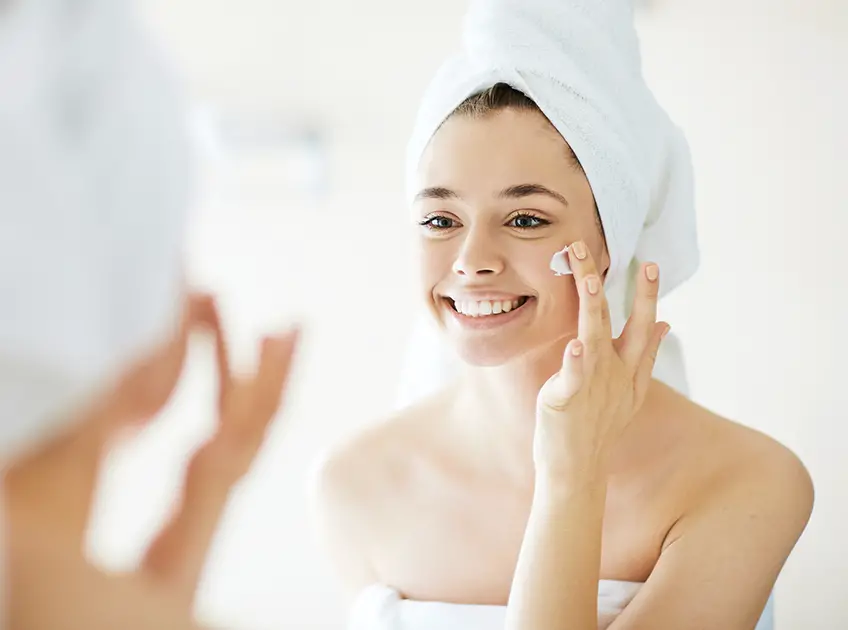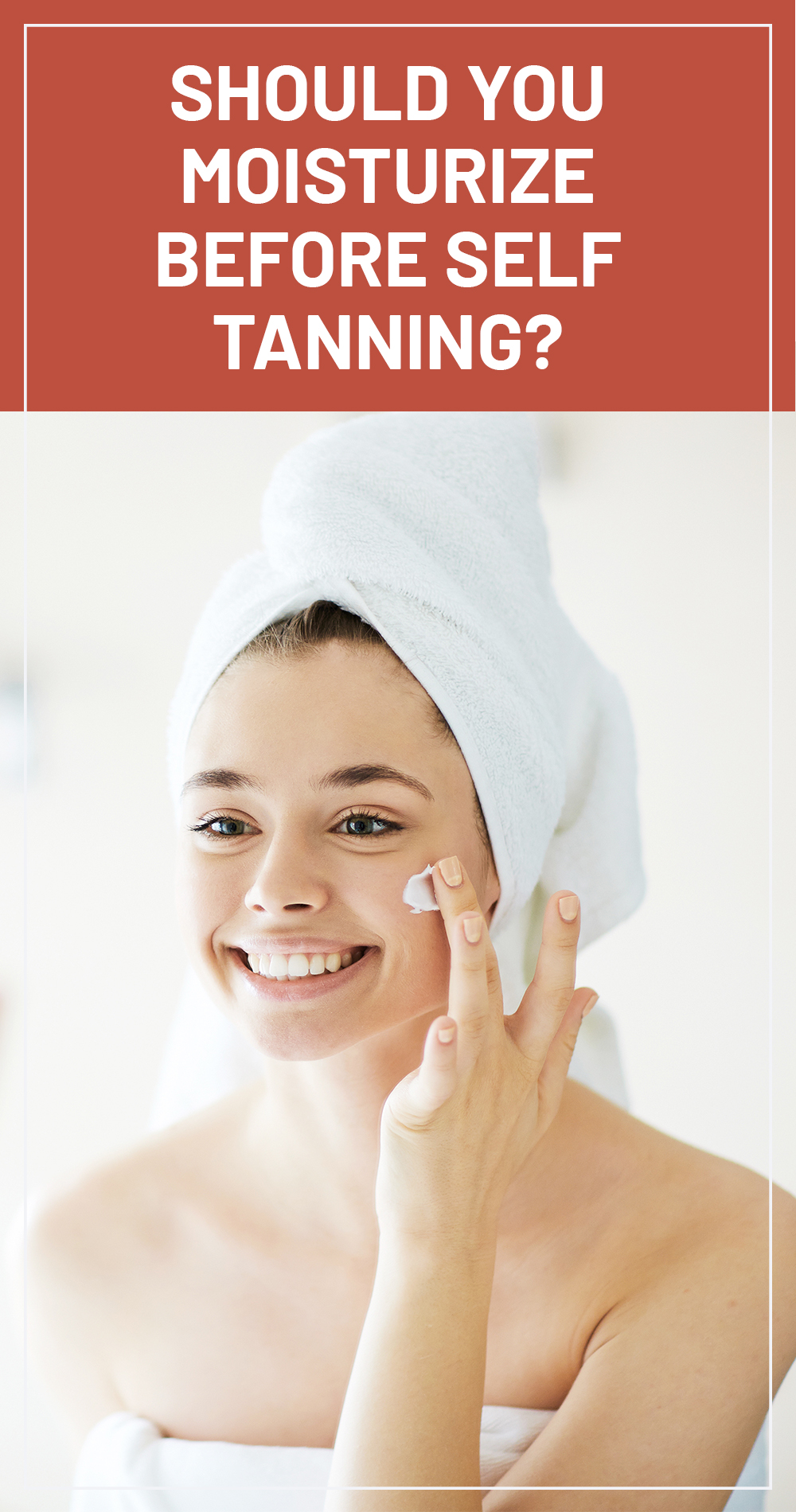
Important: This article is for informational purposes only. Please read our full disclaimer for more details.
Self-tanning gives a beautiful sun-kissed glow to the skin without making it prone to sunburn. If you are planning to get a healthy tan and wondering if should you moisturize before self-tanning, keep reading to clear your dilemmas and get the answer to your queries.
Self-Tanner And Moisturizer
Can I Apply Moisturizer Before Self-tanning?

Yes, applying moisturizer before self-tanning is a healthy practice. It ensures the development of an even tan. Some body parts like hands, feet, knees, and elbows have dry and thick skin. These parts develop and hold self-tanner more easily. Due to this, the chances of uneven tanning increase. When you apply moisturizer before applying self-tanner, tanning occurs more evenly. Let’s understand how moisturizer helps in even tanning and how long you should wait after applying moisturizer to use self-tanner.
How Moisturizer Helps In Developing Even Tan?
The function of a moisturizer is to manage dry skin conditions. Moisturizing skin is an essential part of a good and healthy skin routine. At the same time, it is also a crucial step before self-tanner application. As the name indicates, a moisturizer delivers moisture to the skin and makes it soft and supple. Besides, it helps the outer layers of the skin to retain more moisture and prevents dehydration. If you wonder why skin tans more deeply in certain body parts like knees, elbows, and ankles, it is because they are drier than other body parts. The skin in these areas is thicker and absorbs more tanning solution, developing a darker skin tone. The active ingredient in self-tanners is DHA. As you apply it to the skin, DHA interacts with the dead skin cells and darkens the outer layer of the skin, stimulating a fake tan. Since the dry areas of skin have more dead skin cells, they are more likely to interact with DHA and other chemicals present in the self-tanner. It causes such areas to darken more.
Therefore, it is advised to follow these steps before applying self-tanner
- Exfoliation- Remove the dead skin cells with the help of a quality exfoliant and exfoliation mitt.
- Moisturize- As the dead skin cells shed and fresh skin reveals, apply moisturizer to even out the skin texture and prevent skin dryness.
Apart from making the skin texture even and preventing dryness, moisturizer also aids in prolonging the benefits of self-tanner. As the fresh and moisturized skin is exposed to self-tanner, the tanning solution penetrates and absorbs deeper, ensuring a slower fading of tan.
How Long Should You Wait After Applying Moisturizer To Use Self-tanner?
Since the self-tanning solution can cling to the very dry areas of the skin, it is essential that the skin is evenly textured and well-hydrated before applying the self-tanner. It is advised to apply moisturizer daily for at least a week before tan application. It will ensure that all the body parts are equally hydrated and moist to develop even tan. Take extra care of extra dry areas like knees, elbows, ankles, feet, and hands. Apply moisturizer at least 2-3 hours before tanning. It will give enough time to the skin to absorb the moisturizer and lock it in the uppermost layers of the skin, giving a velvety soft, and smooth texture. It will prevent the skin from absorbing excess tan and looking patchy, instead giving you a gorgeous, radiant glow.
Should You Moisturize After Self-tanning?
Yes, moisturizing the skin, not immediately, but after a few hours, is a good practice to follow after self-tanning. However, you need to use an oil-free moisturizer that simply hydrates the skin without making it oily or greasy. Oil-based moisturizers can break up the dead skin cells that are holding the color and cause it to fade faster and more unevenly.
Mixing Moisturizer And Self-tanner

Although mixing self-tanner or tanning solution with moisturizer will not pose any negative effect on the skin, it is not ideal for blending them. Since both of these products serve different functions, mixing them will not do any good. The best practice is to apply a quality moisturizer, wait for some time to let it sink in properly and then apply self-tanner evenly on the body. Once you are done with self-tanning, you can come back to your normal skin moisturizing routine to improve skin health.
Final Words
Moisturizer plays an important role in the self-tanning process. Apart from keeping the skin hydrated and moist, it also ensures the tan stay longer. At the same time, self-tanners active ingredient, DHA, makes skin prone to damage like it induces premature aging and causes wrinkles and fine lines. The solution to this problem is also the application of some high-quality moisturizer. It will rejuvenate the skin cells and make them healthy and supple like before. Therefore, the answer to should you moisturize before self-tanning is YES. In fact, you should never skip this step before self-tanning.
You Might Also Like:
- 10 Best Exfoliator Before Spray Tan
- How To Exfoliate Before A Spray Tan?- Prevention & Safety Tips
- How And When To Shower After Spray Tan? 8 Aftercare Tips
- Shower After Tanning: What Is The Right Way To Shower After Tanning?
- 7 Easy Ways to Remove Spray Tan (Fake Tan)
- How to Remove Tan with Honey
- How to Remove Tan from Skin Using Lemon Juice?
- 7 Best Home Remedies To Remove Tan
- Waxing After Spray Tan: How Long To Wait?
- Can You Shave After a Spray Tan? How to do
- Makeup Tips for Tanned Skin – A Complete Guide
- Why Won’t My Legs Tan? Tips To Tan Properly
- How to Tan with Fair Skin and Freckles?
- Does Baby Oil Help You Tan?- Is It Safe And Effective To Use?
- How Long Does a Spray Tan Last? Do’s and Don’ts
- How to Get Rid of Dark Underarms Naturally at Home?
- 5 Best Self Tanner For Beginners
- 7 Best Moisturizers For Before Makeup
















